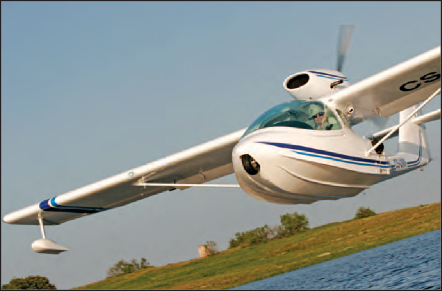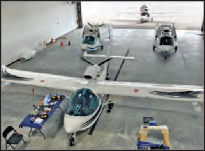Brazilian Seamax M-22 Finds A New Home In The U.S.
The flourishing Brazilian manufacturer of the SeaMax M-22 has established business operations in Daytona Beach, Florida to serve U.S. customers.
(Courtesy SeaMax Aviation)
by Ed Downs
Brazil is a remarkable country. One immediately thinks of Rio de Janeiro, Ipanema Beech, modern cities, an incredible coastline and the wonderous Amazon River which feeds the worlds greatest rain forest. Brazil’s diverse population ranges from sophisticates of the big cities to indigenous people who may never encounter what we might consider “civilization.” But what many do not know is that Brazil is a major player in aviation technology and aerospace manufacturing. With aircraft designs that include military, airline and corporate machines of the highest caliber, Brazilian aviation products compete head on with international aerospace giants in an aggressive market.
In a move that goes counter to today’s withdrawal from business expansion due to the economic crisis created by the COVID pandemic, the flourishing Brazilian manufacturer of the SeaMax M-22 has now established the Embry-Riddle Aeronautical University’s Research Park in Daytona Beach, Florida, as the U.S. home for yet another Brazilian aircraft, this time aimed at sport pilot and recreational flying market. “This has been a very bold but conservative, gradual, and very well planned move for our company,” advocates Shalom Confessor, SeaMax Executive Director for the United States. “ SeaMax is continuously listening to the voice of the customer and the most prominent aviation experts and (we) connected with the most reputable aviation institutions on the globe before we decided to bring the assembly operations to the United States,” adds Confessor. For the company CEO, Dr. Gilberto Trivelato, the SeaMax assembly in the U.S. “will allow the company to integrate and leverage the SeaMax M-22 aircraft as a business and the company future developments and projects into the U.S.A. existing cluster to accelerate further our technology and business capabilities by the exchange of know-how.”
The SeaMax M-22 in front of its hangar on the Embry-Riddle Aeronautical University's Research Park in Daytona Beach. (Courtesy SeaMax Aviation)
The SeaMax M-22 is a high-performance amphibious Light-Sport Aircraft (FAA certified S-LSA) designed to meet the harsh demands made of aircraft serving the needs of Brazilian flyers. While an excellent network of hard surface airports certainly exists in Brazil’s major population centers, the vast expanse of the rain forest is served by massive rivers, lakes, and seasonal flooding.
The SeaMax M-22 is an experienced designed for global sales. It has been on the market for more than 20 years and received several awards world-wide. Built of composite materials and pursuant of the safest records in the category, this sophisticated aircraft’s unique- ness relies upon its ability to remain light, granting exceptional performance, long range, and an outstanding useful load.
The Daytona Beach campus provides easy access to waterways for the amphibious M-22.
(Courtesy SeaMax Aviation)
While primary airframe manufacturing remains in Brazil, final assembly of SeaMax M-22s being sold in the United States has now been located in Daytona Beach. This move will insure cost savings, quality, and local customer support. The Daytona Beach facility will serve as a hub for future expansion of a dealership program. But let’s not get ahead of the full story and take a look at how this cool little plane came to be.
In 1998 Miguel Rosario, an engineer, designer, and draftsman conceived his 22nd project, the SeaMax M-22, an aircraft that has become a worldwide success. Since 2001, Rosário dedicated his time and efforts to the development and prototype testing of the SeaMax M-22. The first production M-22 aircraft was delivered in 2002. In 2004, the FAA introduced a new category of aircraft for General Aviation, called Light-Sport Aircraft (LSA), and the SeaMax M-22 design was submitted for entry into this new classification. Certified by the FAA in the S-LSA category (Special Light-Sport Aircraft, allowing manufacture of a ready-to-fly airplane) was granted in 2008. In 2011, the company moved its headquarters from Rio de Janeiro, Brazil into a more sophisticated site in São João da Boa Vista, São Paulo, Brazil and began steady production of four aircrafts per month. In 2012 SeaMax was award- ed “Outstanding Best Commercial S- LSA” at the renowned Sun ‘n Fun Aviation Expo in Lakeland, Florida.
The SeaMax M-22 features a foldable wing version.
(Courtesy SeaMax Aviation)
In June 2014, Gilberto Cunha Trivelato, a prominent engineer with an expertise in Defense Systems and Aerospace technologies acquired the company with the primary objectives of maintaining intellectual property and stabilizing the industrial plant in Brazil. In order to meet these objectives, Trivelato made it a priority to resume and expand production and develop new aircraft, such as unmanned vehicles, agricultural aircrafts, and a 5-seat plane. The company re-established its production capacity by hiring and empowering employees and applied for approval from the ANAC – Brazilian Aviation Authority.
Shortly thereafter the SeaMax M-22 foldable wing version was introduced. The SeaMax M-22 has appeared on more than 40 specialized aircraft magazine covers all over the world and simultaneously became a model for FAA Certification standards for the LSA category.
The SeaMax M-22 was the first amphibious aircraft to obtain the Type Certificate in Europe in 2005, even before the effectiveness of the Special Light Sport Aircraft (S-LSA) category. After the ruling of the equivalent category in Brazil, the Aerovane Leve ESportiva Especial (ALE- E), which became effective in 2017, the SeaMax M-22 obtained the final approval of ANAC in April 2019. Today, after 19 years of Research and Development and continuous improvements and enhancement, SeaMax is certified by Aviation Authorities in 19 countries and has sold hundreds of units in 20-plus countries. Bottom line … the SeaMax M-22 is an experienced, sophisticated design by a company with an inter- national history of success.
The Amphibious Light-Sport Aircraft was originally designed to meet the needs of Brazilian flyers, especially in and around the country's Rain Forests.
(Courtesy SeaMax Aviation)
What kind of performance might one expect out of the SeaMax M-22? Typically, one expects to lose some overall performance in a dedicated hull type, seaplane. Being airworthy is one thing, but adding sea worthiness to the fuselage design of a plane’s fuselage, as well as wing mounted tip floats and “repositionable” landing gear needed to get the “amphibius” label can result in wight and/or performance com- promises. The SeaMax M-22 seems to dis- regard traditional thinking, and ends up with climb, cruise, payload numbers and take-off/landing performance that challenges most other “landbound” Light Sport Aircraft.
Final assembly of the M-22 takes place in Daytona Beach for planes sold to U.S. customers. (Courtesy SeaMax Aviation)
Powered by the 100 hp Rotax 912 ULS or available 912 iS (both engines have a 2000 hour TBO), one can look forward to cruise speeds of 115 mph, with fuel consumption as low as 4.5 GPH. The 26 gallon tanks can offer a range of up to 600 miles, with VFR reserves. With the LSA limiting gross weight of 1320 lbs. and an empty wight that will range between 715 lbs. to 815 lbs. (depending upon equipment choices), the useful load can be as high at 600 lbs. Doing the math, with full tanks, which leaves a payload ranging between 350 lbs. and 450 lbs. Pretty impressive numbers for a very light airplane that must also float! Take-off and landing distances are listed as being in the 500-foot range.
With a strong history behind it, the SeaMax M-22 is now certified by aviation authorities in 19 countries. (Courtesy SeaMax Aviation)
The M-22 seems to disregard traditional thinking and ends up with climb, cruise, payload number and take off/landing performance that beats other LSAs.
(Courtesy SeaMax Aviation)
To be sure, this is a very practical air- plane, loaded with fun! Most S-LSA air- craft are priced higher than many of us would like to see, with prices ranging from $100K to well over $300K. Prices for the SeaMax M-22 begin in the range of $149K and climb to a high of about $189K, depending upon options chosen. The value received in function and fun far exceeds the middle of the road pricing. One has to experience the freedom of an “amphib” in order to fully appreciate just how many resort quality landing adventures land- locked pilots pass over on virtually every flight. For additional information, visit www.seamaxair craft.com, or call SeaMax U.S.A. at (260) 460-7587.








